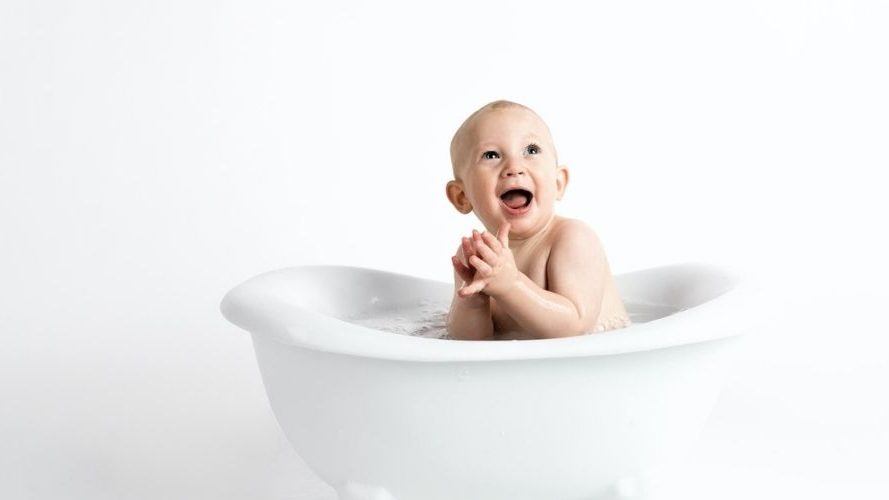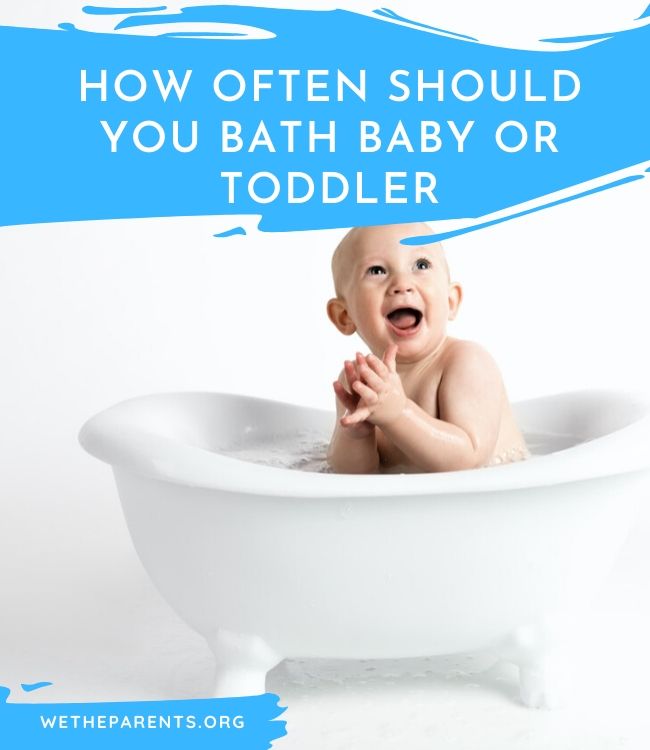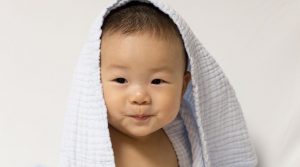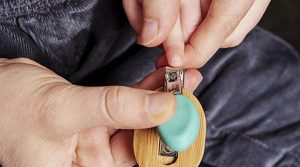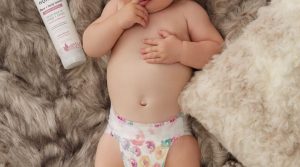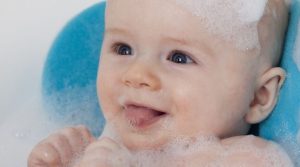Wondering how often you should bathe your baby or toddler? If so, don’t feel embarrassed! Many parents find themselves googling questions about parenthood that, once upon a time, would have seemed obvious.
As it turns out, there are a plethora of opinions about how often we should bathe our youngsters each week.
In this article:
Why bathing is good
Let’s face it: kids get dirty by just existing! From the occasional spit-up from an infant to the toddler deciding to mash food all over himself, it’s no surprise that kids need baths to remain clean and smelling fresh. Yet bathing does more than promoting good hygiene.
Bonding: Creating and maintaining a bond with your child is vital to their development. If you’re a mom to a biological child, you have a head start on fostering the parent-child relationship.
You have already begun to form a bond during pregnancy, and the gentle touch of your baby as you bathe him increases this connection.
If you have adopted, used a surrogate, or are a proud papa, bathtime is a great opportunity to further develop that parental bond. Talking while bathing, giving gentle massages, keeping lots of eye contact, are all important bathtime activities.
Free play: Babies and toddlers love bathtime because they get to play with toys, splash around, and, when old enough, use their imaginations to turn their tub into a magical world. This is not only fun, but can also encourage cognitive development and allow for great bonding opportunities.1Bathing Your Baby
healthychildren.org/English/ages-stages/baby/bathing-skin-care/Pages/Bathing-Your-Newborn.aspx
Editor’s Note:
Bath toys are more appropriate for infants six months and older when vision has fully developed and fine motor skills have matured enough to grasp the toys.
Bedtime and baths: Washing your baby means lots of gentle touching and massaging, which stimulates the vagus nerve, leading to a slower heart rate, lower blood pressure, and even triggering a state of calmness within the brain. Most of us would have an easier time falling asleep in this state!2LEE, H. K. (2002). Effects of sponge bathing on vagal tone and behavioural responses in premature infants.Journal of clinical nursing, 11(4), 510-519.
unboundmedicine.com
Skin checks: Babies can be prone to an array of skin issues, such as eczema, allergies, and diaper rash. It’s essential to regularly check your little one for any signs of these ailments, and bathtime provides the perfect opportunity to give your baby’s skin a regular once-over.
Avoid bathing immediately after birth
The World Health Organisation currently recommends that caregivers wait at least 6 hours, preferably 24 hours, before bathing a newborn.
Your baby is born covered with vernix caseosa, a protective layer consisting of water, protein, and fats. This moisturizing film minimizes friction while your baby passes down the birth canal.
Once your baby is born, it can help prevent the skin from cracking or peeling by locking in moisture if left in place. There is also some evidence that the vernix caseosa can help your newborn’s body to regulate its temperature.3Bathing Your Baby
healthychildren.org/English/ages-stages/baby/bathing-skin-care/Pages/Bathing-Your-Newborn.aspx
Doctors also suggest being patient before giving the first bath to avoid separating mother and child during a crucial bonding period.
Babies that remain with their mothers immediately after birth often breastfeed with more ease than those whisked away for a bath.4Delayed Bathing
icea.org/wp-content/uploads/2018/02/ICEA-Position-Paper-Delayed-Bathing.pdf
How often should you bathe your baby?
The American Academy of Pediatrics advises parents to give their newborns sponge baths until the umbilical cord’s stump has fallen away, and the navel has healed. If your baby has recently been circumcised, all bathing should be done with a sponge while that area heals. 5Infant and toddler health
Print
mayoclinic.org/healthy-lifestyle/infant-and-toddler-health/in-depth/healthy-baby/art-20044438
Once your latest little family member is all healed up, begin giving them more traditional baths by partially filling a tub, sink, or basin with water.
You might find that your baby has grown to love bathtime between the ages of three and twelve months. In this case, you can bathe him more often for relaxation purposes or just allow him to play in the water. It’s best to only use baby-friendly soap for one or two baths per week.66 to 12 months
healthline.com/health/baby/how-often-should-you-bathe-a-newborn#6-12-months
Remember, you can always ‘spot clean’ in lieu of a full bath when your baby has a diaper blowout or a spit-up. Younger infants can pass up to six stools per day, especially when breastfed.
Irritation can develop if the diaper area is not well cleaned after stooling. In clinical practice, I recommend that parents rinse the baby’s bottom under warm water in a sink after stooling.
This cleans the area more effectively and prevents the need for frequent wiping, which can further irritate your child’s sensitive skin.
How often should you bathe your toddler?
It’s no secret that toddlers throw themselves at life and can make quite a mess doing so. It’s best to give them a soak more often, especially if they’ve been wearing suntan lotion or bug repellent. If you choose to use a baby wash, most are formulated to be gentle on infant skin. 7Blume‐Peytavi, U., Lavender, T., Jenerowicz, D., Ryumina, I., Stalder, J. F., Torrelo, A., & Cork, M. J. (2016). Recommendations from a European roundtable meeting on best practice healthy infant skincare.Pediatric Dermatology, 33(3), 311-321.
ncbi.nlm.nih.go
How to give a sponge bath
To give the best sponge bath, you should: 8Bathing Your Baby
healthychildren.org/English/ages-stages/baby/bathing-skin-care/Pages/Bathing-Your-Newborn.aspx
- Pick a flat surface (e.g. changing table or countertop) in a warm room.
- Fill a sink or basin with warm water.
- Wrap your baby gently in a blanket or towel and place him on the flat surface, always keeping a hand on your child.
- Wet a soft washcloth, wringing out excess water.
- Carefully wipe your baby’s eyelids from the inside corner out with plain water.
- Gently wipe the rest of his face, paying particular attention to the area behind his ears, with plain water.
- Pat the skin dry and put a hat on your child to keep him warm.
- Bathe your baby in sections, uncovering and re-covering each area as you wash to keep him warm.
- Be sure to get in between the fingers and toes and wash within all those cute creases around his diaper area and under his arms.
- Follow up with an appropriate lotion to protect the skin.
How to bathe your baby
- Fill a basin, tub, or sink with 2 or 3 inches of lukewarm water.
- Lie a warm towel on a flat surface near where you are bathing.
- Gently wash your baby’s face with a washcloth dampened by plain water, washing his eyelids from the inside corner outwards.
- Wash his hair with gentle, baby-friendly shampoo, if desired, and rinse well. Take extra care that soapy water doesn’t drip into his eyes.
- Place your baby on the towel and gently dry his hair and face before placing a hat over his head.
- Place your baby in the tub.
- Put a small amount of soap on the washcloth if desired and gently cleanse his skin, starting at the chest and working your way out and then down. Be sure to pay special attention to the diaper area, wrinkles, and in between the fingers and toes.
- Remove your baby from the tub, wrap him in a blanket, and replace his diaper as soon as possible.
Editor’s Note:
For hair washing, keep the shampoo away from the baby’s eyes by massaging it onto the scalp using motions toward the back of the head.
Rinsing the shampoo is easiest by allowing warm water to run off the back of the head and away from the eyes.
Check out this video for a step-by-step demonstration.
How to bathe your toddler
Your bathing method won’t change too much as your kiddo enters his toddler stage. You’ll want to:
- Fill the tub, sink, or basin with a few inches of water, or until it reaches your child’s waist.
- Place your child into the water.
- Gently start washing him from the head down, paying attention to the same areas you did when he was younger. Soap is still optional at this point.
- Dry your kiddo off and apply liberal amounts of lotion to his skin.
Bathtime tips
- Always have everything you need within reach
- Check the water temperature to be sure it’s safe for the baby
- Put a non-slip mat in the tub for your older baby
- Keep a hand on the child at all times
- Teach your toddler not to stand in the tub
- Make sure your toddler doesn’t begin playing with the water handles
- Keep baths short
- Maintain a positive attitude during bathtime
- Infant bath seats are a safety hazard and not recommended 9Infant Water Safety: Protect Your New Baby from Drowning
healthychildren.org/English/safety-prevention/at-play/Pages/Infant-Water-Safety.aspx - Always supervise bathtime
Reasons to not over bathe
Believe it or not, there’s a lot of support for the ‘less is more’ approach when it comes to babies and baths. So why and when should you go against your natural instinct to keep your kiddo squeaky clean?
Firstly, your little one has skin that’s thin and unable to retain moisture, and too many dips in the tub can sometimes make this worse, especially if you’re regularly using soap or shampoo.
If you notice your kiddo has started sporting flakey patches of dry skin, you should:
- Reduce bath time to 3-5 minutes per soak
- Put away the soap for a while, and just use plain water
- Make sure the water isn’t too hot
- Be sure to thoroughly dry your kiddo before putting diapers or other clothing on
- Use a hydrating lotion on your baby’s skin after each bath 10Baby Skin Care Slideshow: Simple Tips to Keep Baby’s Skin Healthy
webmd.com/parenting/baby/ss/slideshow-baby-skin-care - Consult a doctor if these measures are not effective
Germy benefits
Though it sounds counterintuitive, letting your baby have some exposure to bacteria and viruses can be GOOD for their immune health. Exposure to these elements causes the creation of antibodies, allowing your child’s immune system to become more robust.
With that said, be careful not to unnecessarily expose your baby to illnesses. 11Keeping Baby Healthy: Protection From Germs at Home
webmd.com/parenting/features/germs-at-home#1
You’re tired!
You may want to be ‘super mama’ all the time, but motherhood is exhausting! You have lots of essential things to do, like regular feedings and constant diaper changes, to keep your child alive and healthy.
For now, frequent baths may not figure among those things, so don’t bend over backward to squeeze in extra tub time.
You don’t want your baby to associate negative tension with bathtime, but, rather, for those cleansing suds to have joyful, loving connections.
Eczema and baby baths
A common skin ailment among babies, eczema is characterized by red patches of crusty skin. It can be made worse by dry skin, soaps that are too harsh, and allergies.
Infants usually outgrow this condition, but it’s wise to seek a medical opinion on whether or not medication is warranted.
Avoiding harsh products while your baby is healing from eczema, you can still bathe him using gentle, fragrance-free soaps or just plain, lukewarm water.
Adding baby-safe oatmeal products to the bath can help relieve itchiness, though don’t let your little one soak for more than 10 minutes. 12Does My Baby Have Eczema?
webmd.com/parenting/baby/baby-eczema-questions-answers#1
Editor’s note:
If your baby’s eczema seems to worsen with the use of an oatmeal-based product, this could be a sign of an allergy to oats.
In clinical practice, I have seen this phenomenon as young as four months. If this occurs, it should be discussed with your baby’s doctor as it could affect when oats are introduced as a first food into the diet.
Making bathtime fun
Bathtime doesn’t have to be all cleaning and no fun. There are plenty of ways to engage your baby and put him at ease if water makes him nervous.
Tickle and touch
You’ll be hard-pressed to find a baby who doesn’t giggle with the occasional tickle. If that’s not really your kiddo’s style, then opt for a soothing massage or gentle strokes along his skin. Nothing makes a baby happier or more at ease than your loving touch.
Blow bubbles
You’re going to have to clean up after a bath anyway, so what’s wrong with a few more damp spots to wipe up? Many babies are left in awe as they watch an array of bubbles float around the room. It might even give you the distraction you need to clean between your little one’s toes!
Songs and stories
Though you may not have the voice of an angel, don’t be afraid to burst into song whenever your kiddo is in the tub. Not gonna happen? That’s okay; you could always tell a story. Either one is great at engaging babies and encourages further bonding.
Toys
You can never go wrong with bath toys. I can even remember some of my favorite bathtime trinkets to this day! Just remember to clean them regularly (while checking for mold growth, etc.) and buy large toys that small hands can grab.
Conclusion
How often you bathe your baby or toddler is, in many ways, a matter of personal preference.
Just remember to wait until the umbilical cord stump falls off, and the navel (or any circumcision incision) has healed before graduating from sponge baths.
After that, you need only bathe your baby a few times a week. If you choose to wash your child more often than that, don’t overdo it with soapy products, keep an eye out for dry skin, and, most importantly, always make bath time fun for you and your child. Happy bathtub sailing!


